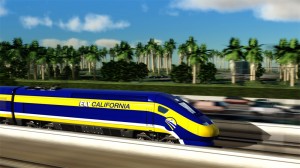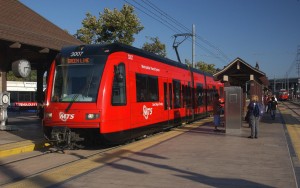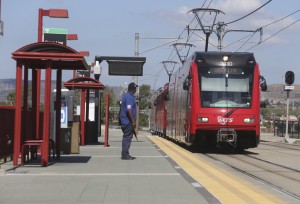 The one place California should be building high speed rail immediately is between Los Angeles and San Diego. As I’ve blogged before, the two big cities are too close to fly and too painful to drive conveniently, due to traffic. That makes them perfect for high speed rail. The line would likely be the most lucrative of any in the state.
The one place California should be building high speed rail immediately is between Los Angeles and San Diego. As I’ve blogged before, the two big cities are too close to fly and too painful to drive conveniently, due to traffic. That makes them perfect for high speed rail. The line would likely be the most lucrative of any in the state.
So of course it’s slated to be the last line built in the statewide high speed rail plan. But transportation researcher Alon Levy makes a case in Voice of San Diego that the current line could be upgraded relatively inexpensively, given new federal rules that allow lighter European trains to run on U.S. tracks:
This means that the region needs to invest in electrifying the corridor from San Diego to Los Angeles, and potentially as far north as San Luis Obispo. Between San Diego and Los Angeles, the likely cost – based on the California high-speed rail electrification cost – is about $800 million.
The benefits are considerable. Electric trains emit no local pollution, while diesel is an unusually dirty fuel, contributing to Southern California’s poor air quality. New EPA rules, the Tier 4 standards, have required rail agencies in the U.S. to buy cleaner-burning diesel locomotives. The Pacific Surfliner has recently bought Tier 4-compliant locomotives, but many intercity and commuter rail routes around the country are interested in such trains, so they could likely fetch a good price by selling them now on the second-hand market. While these locomotives are cleaner than the legacy ones they replace, they are almost as heavy, and are unsuitable for a fast operation.
Levy also recommends specific track upgrades, such as running trains along I-5 to avoid Miramar Hill, which slows down the trains considerably as they wind up it. Ultimately, with these improvements, train times between the cities could clock in at less than two hours — competitive with driving even without traffic. And with full high-speed rail service, the estimated travel time would be closer to 1 hour and 20 minutes.
Local leaders in the three affected Southern California counties should act immediately to invest in these upgrades. A multi-county bond issue could probably provide the sufficient dollars, and I’m guessing it could get public support with the right campaign.
Meanwhile, the benefits for the local rail transit systems in the two cities would be immense. Passengers getting off the high-speed trains in Union Station would be more likely to hop on a Metro Rail train to Pasadena, Long Beach, Hollywood or Santa Monica, while train passengers in San Diego could take the trolley around the region, boosting ridership on both systems.
The upgrade is really a no-brainer when it comes to boosting train service. It will just take the political will and the dollars needed to finance it.
Voice of San Diego ran an excellent piece assessing San Diego’s Gillespie Field trolley stop, ranked in our recent study as the worst station neighborhood in all of California. As reporter Maya Srikrishnan reports:
Nearly 3,500 people live in the half-mile area surrounding that station, and about 4 percent of residents and 6 percent of workers take transit. Seven percent of the nearby residents don’t have their own vehicle.
To put those numbers in context, the stations in downtown, urban neighborhoods are surrounded by far more people, and a much larger share of them rely on transit. The half-mile area around the 12th and Imperial Station has a population of 9,529 (five times Gillespie Field), and about 31 percent of residents and 14 percent of workers use the trolley (seven times and three times more than Gillespie). About 26 percent of households in the half-mile radius don’t own vehicles, four times more than near Gillespie. The numbers are similar at the other high-ranking San Diego station at Civic Center.
I spent an hour last Wednesday morning – from 9 to 10 a.m. at the Gillespie station. Only one person got on a train. I had missed the commuter crowd, but the station’s parking lot wasn’t even half full. Our photographer spent 40 minutes taking pictures of the station on Tuesday and only two people boarded.
The next day, as people went home from work from nearby warehouses and manufacturing and other industrial companies around 5 p.m., the trolley station was a bit more crowded. But even during rush hour, a maximum of 10 people boarded any given train.
“It’s a good stop,” said Brittney Scott, who commutes from Lemon Grove on the trolley every day to her job at the House of Magnets warehouse – about a 10-minute walk from Gillespie Field Station. “Nice view, no one here.”
“This station is cleaner,” Scott said. “But it’s because no one uses it.”
It was always my hope that the study would motivate more attention on under-performing rail station neighborhoods. And the good news is that the East County Economic Development Council in San Diego may now try to implement a March 2015 plan to spur development in the area. According to the article, on Tuesday, the Council’s airport committee will review an agreement with a consultant to further develop plans for the area and seek partnerships with developers to implement the plan.
They cite the need for financing as one potential barrier, so this is a good area for state policy to help, perhaps through infrastructure finance districts or cap-and-trade funding. But it’s good to see local willingness to improve the area. That’s the crucial first step.
 In the rail station area grades we released last week, two regions finished at the bottom of the heap in encouraging smart growth: Santa Clara and San Diego. I have to admit, I have not heard much of a response from people in the San Jose/Santa Clara area, which is surprising given how much the Bay Area prides itself on transit and connectivity.
In the rail station area grades we released last week, two regions finished at the bottom of the heap in encouraging smart growth: Santa Clara and San Diego. I have to admit, I have not heard much of a response from people in the San Jose/Santa Clara area, which is surprising given how much the Bay Area prides itself on transit and connectivity.
But in San Diego, there’s been much coverage of the results (see my San Diego Union-Tribune op-ed in response, co-authored with Next 10’s F. Noel Perry, here). Unfortunately, much of it has been directed at San Diego MTS, as I blogged about last week. But Voice of San Diego grasped the implications of the low grades:
The study’s most critical conclusions weren’t directed at the Metropolitan Transit System or its stations. They keyed on decades of development decisions by the city of San Diego and other cities along the trolley lines.
It quantified a phenomenon that’s long been apparent anecdotally: Local leaders support smart growth – urban development that’s crucial for transit ridership – in theory, but not in practice.
They are not planning for or facilitating enough construction of walkable, affordable housing near transit access points.
Writer Andrew Keatts gives some specific examples of where local policies have thwarted transit-oriented development:
Last year, for instance, San Diego’s planning department released a study recommending the city increase the amount of development allowed at two new trolley stops planned as part of a $1.7 billion light-rail extension from Old Town to University City.
Residents revolted. They demanded the city not increase the 30-foot limit on new buildings near the station proposed for Clairemont Drive, or increase the number of homes that could be built in the area.
Mayor Kevin Faulconer quickly directed city staff to announce it wouldn’t raise the height limit.
I’m glad to see reporting on these kinds of instances, because these local decisions more than anything else determine the low scores of the station areas in places like San Diego. It will take some combination of public pressure and regulatory and financial incentives to overcome this dynamic.
Count me among the believers that the most sensible high speed rail route in California is between Los Angeles and San Diego. The two cities are 120 miles from each other — too close to fly and painfully slow to drive during most daytime hours. Amtrak takes almost three hours to get there.
But a high speed rail route could chop that distance to 45 minutes — a huge value-add to connect the cities, which would do wonders economically and for quality of life. The line would pay for itself in fare revenue.
So of course it will likely be the last section of high speed rail to be built in California. And some people in San Diego are not happy about it, according to the San Diego Union Tribune:
Even with lukewarm support from the region, then San Diego Mayor Jerry Sanders took a strong stand in favor of high-speed rail after the [2008 state high speed rail] bond passed.
“We stand firmly behind high-speed rail and will do all we can to bring it to San Diego,” Sanders told the authority’s board at its February 2010 meeting in San Diego. “It will help fuel our economy, help the environment and improve our quality of life.”
Reached by phone on Friday, Sanders, who now heads the San Diego Regional Chamber of Commerce, said he’s no longer a bullet train backer.
Sanders said he supported the project because he thought San Diego would be included early on, but delays have convinced him that the state’s money would be better spent bolstering the region’s existing rail connections.
“We haven’t seen any progress,” Sanders said. “They’re not even talking about San Diego-to-LA at this point, which is too bad.”
The California High Speed Rail Authority doesn’t plan to break ground on the San Diego-to-Los Angeles link until after it completes the San Francisco-to-Los Angeles section in 2029. That’s too bad. But I hope in the meantime the state will consider either a concurrent start in San Diego or upgrades to the Amtrak line to get it running to 110 miles per hour. It would be a great demonstration of a successful high speed rail line in California and provide immediate benefits for the millions of people in that corridor.



